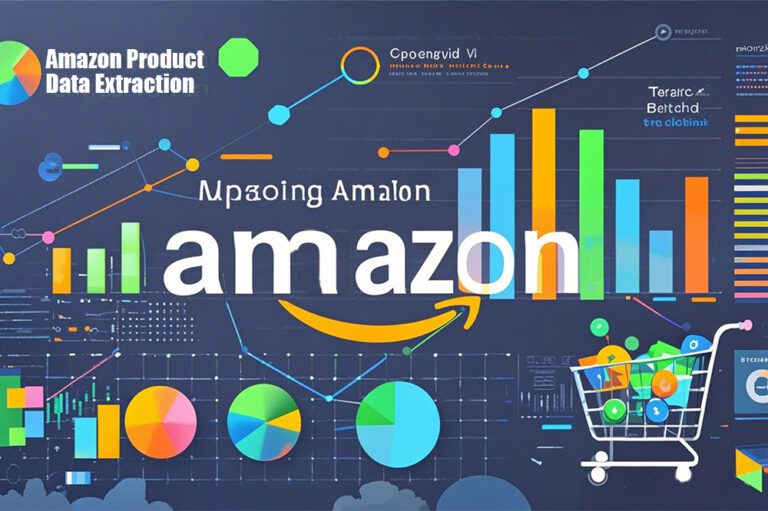Introduction
The Importance of Product Data in Amazon E-commerce
In the world of e-commerce, data-driven decision-making is crucial. For sellers operating on Amazon, having access to accurate, real-time product data is essential for maintaining a competitive edge. From pricing to inventory management, data allows sellers to optimize product listings, increase sales, and improve profit margins.
Overview of Amazon Product Data Extraction
Amazon product data extraction refers to the process of retrieving various types of data related to products on Amazon, including price, sales rank, reviews, and inventory. This process helps sellers understand market trends, analyze competitors, and optimize their product strategies. However, extracting Amazon product data comes with a set of challenges, such as complex site structures, dynamic content, and rate limitations.
Main Types of Amazon Product Data
Before diving into the extraction process, it is essential to understand the different types of data and how they play a role in e-commerce operations.
2.1 Basic Product Information
Basic product information is the foundational data on an Amazon page, typically including product name, description, ASIN (Amazon Standard Identification Number), brand, and model. This data is crucial for product comparison and analysis.
2.2 Price Data
Price is one of the most critical factors influencing purchasing decisions. By collecting price data, sellers can monitor price changes, understand competitor pricing strategies, and adjust their own pricing to stay competitive.
2.3 Sales Rankings and Bestsellers Lists
Amazon’s bestseller lists and sales rankings are key indicators of market demand and product performance. By extracting this data, sellers can identify potential bestselling products and optimize their product strategies in real-time.
2.4 Customer Reviews and Ratings
Customer reviews and ratings reflect consumer satisfaction and real product experiences. This data helps sellers identify product strengths and weaknesses, allowing them to improve product quality or services to enhance customer satisfaction.
2.5 Competitor Data
Beyond your own product data, understanding competitor activity is equally important. By extracting competitor product information, prices, and sales rankings, sellers can adjust their marketing strategies to stay ahead in the market.
Challenges of Amazon Product Data Extraction
While extracting product data from Amazon, sellers often encounter several technical and operational challenges.
3.1 Website Structure and Dynamic Content
Amazon’s website structure is complex, with different HTML layouts for various pages. Additionally, Amazon uses JavaScript to dynamically load content, making traditional static scraping tools ineffective for capturing these elements.
3.2 Data Accuracy and Consistency
Ensuring the accuracy and consistency of the collected data is another challenge. Changes in page structure, differences in data formats, and errors during extraction can lead to incorrect or incomplete data, which can negatively impact decision-making.
3.3 Rate Limits and IP Blocking
Amazon imposes rate limits on excessive scraping activity, which can trigger IP blocking or CAPTCHA challenges. If data is collected too frequently, Amazon may block access entirely.
3.4 Handling Large Volumes of Data
Extracting large amounts of data brings storage and processing challenges. Managing and storing vast datasets efficiently while ensuring their usability is crucial for successful data extraction.
Effective Strategies for Amazon Product Data Extraction
To overcome these challenges, several effective strategies can be implemented to ensure a smooth data extraction process.
4.1 Targeted Data Extraction
Focusing on Specific Product Categories
By focusing on specific product categories, you can efficiently gather relevant data without collecting irrelevant information. This also improves the efficiency of data analysis.
Collecting Data Based on Keywords
Keywords are essential for product search and data extraction. By setting specific keywords, web crawlers can extract all product information related to those keywords. This is particularly useful for sellers optimizing their keyword strategies.
4.2 Location-Based Data Extraction
Importance of Zip Code-Specific Data
Data such as prices and inventory can vary by geographic location. By extracting data based on specific geographic locations (e.g., zip codes), sellers can analyze regional market demand and pricing fluctuations, enabling them to create localized sales strategies.
Techniques for Collecting Location-Based Data
To collect location-based product data, you can include geographic parameters in your HTTP requests or extract data from different Amazon regional sites (e.g., .com, .ca, .uk).
Tools and Techniques for Amazon Product Data Extraction
5.1 Web Scraping Libraries
Python is a preferred language for building Amazon product web crawlers. Below is a simple Python web scraper that retrieves basic product information and price data.
import requests
from bs4 import BeautifulSoup
# Set headers to mimic browser request
headers = {
'User-Agent': 'Mozilla/5.0 (Windows NT 10.0; Win64; x64) AppleWebKit/537.36 (KHTML, like Gecko) Chrome/58.0.3029.110 Safari/537.3'
}
# Target product URL
url = 'https://www.amazon.com/dp/B08N5WRWNW'
# Send the request
response = requests.get(url, headers=headers)
# Parse the HTML content
soup = BeautifulSoup(response.content, 'html.parser')
# Extract the product title
title = soup.find('span', {'id': 'productTitle'}).get_text(strip=True)
print("Product Title:", title)
# Extract the product price
price = soup.find('span', {'class': 'a-price-whole'}).get_text(strip=True)
print("Product Price:", price)
5.2 Proxy Services
To bypass Amazon’s IP blocking and rate limits, proxy services are essential. Below is a code example that integrates proxies with data extraction.
import requests
from bs4 import BeautifulSoup
# Proxy settings
proxies = {
'http': 'http://your_proxy_ip:port',
'https': 'https://your_proxy_ip:port'
}
headers = {
'User-Agent': 'Mozilla/5.0 (Windows NT 10.0; Win64; x64) AppleWebKit/537.36 (KHTML, like Gecko) Chrome/58.0.3029.110 Safari/537.3'
}
url = 'https://www.amazon.com/dp/B08N5WRWNW'
# Send request using proxies
response = requests.get(url, headers=headers, proxies=proxies)
# Parse content
soup = BeautifulSoup(response.content, 'html.parser')
title = soup.find('span', {'id': 'productTitle'}).get_text(strip=True)
price = soup.find('span', {'class': 'a-price-whole'}).get_text(strip=True)
print("Product Title:", title)
print("Product Price:", price)
5.3 Data Storage Solutions
The extracted data can be stored in different databases. For small-scale data storage, CSV files or SQLite databases can be used. For large-scale data extraction, MySQL or MongoDB is recommended.
import csv
# Example list of product data
data = [
{"title": "Product 1", "price": "100"},
{"title": "Product 2", "price": "200"}
]
# Write data to a CSV file
with open('amazon_products.csv', mode='w', newline='') as file:
writer = csv.DictWriter(file, fieldnames=["title", "price"])
writer.writeheader()
writer.writerows(data)
Pangolin Data Services: A Comprehensive Solution for Amazon Product Data Extraction
6.1 Introduction to Pangolin Data Services
Pangolin is a professional Amazon product data extraction solution offering efficient API interfaces to help sellers automate and extract real-time data. It is a comprehensive and flexible tool suitable for businesses of all sizes.
6.2 Pangolin’s Product Suite
6.2.1 Scrape API
Pangolin’s Scrape API provides powerful capabilities for extracting a wide range of Amazon product data from product pages.
- Features and Benefits: Scrape API allows users to flexibly collect bestseller lists, product descriptions, prices, and more.
- Use Cases: Users can quickly extract bestseller data or collect product information based on specific keywords using Scrape API.
6.2.2 Data API
Pangolin’s Data API provides real-time data parsing capabilities, particularly useful for price and inventory tracking.
- Real-Time Data Parsing: Data API can retrieve real-time price and inventory data, helping sellers adjust pricing strategies promptly.
- Applications: Sellers can monitor price fluctuations and ensure competitiveness by using Data API.
6.2.3 Pangolin Collector
Pangolin Collector is a user-friendly visualization tool ideal for non-technical users to quickly gather Amazon data points.
- Features: It displays the data extraction process in an intuitive interface and outputs data in formats such as Excel for further analysis.
- Ease of Use: Non-technical users can complete complex data extraction tasks without coding.
Advanced Amazon Product Data Extraction Techniques with Pangolin
7.1 Bestsellers Data Extraction
Pangolin provides automated tracking of Amazon bestseller lists. Sellers can set automated monitoring of top-selling products in specific categories and gain access to real-time data.
7.2 Keyword-Based Data Extraction
Pangolin helps sellers collect product data based on specific keywords and analyze keyword performance trends, allowing for optimized marketing and advertising strategies.
7.3 Zip Code-Specific Data Extraction
Pangolin’s tools allow sellers to extract location-based pricing and inventory data, helping them understand regional market differences and develop localized sales strategies.
Ensuring Data Quality and Compliance
8.1 Data Validation and Cleaning
To ensure data accuracy, validation and cleaning processes must be applied after extraction to remove invalid or duplicate data.
8.2 Compliance with Amazon’s Terms of Service
All data extraction activities must comply with Amazon’s Terms of Service to avoid account suspension or IP blocking.
8.3 Ethical Considerations in Data Extraction
In addition to legal compliance, ethical considerations should be taken into account, such as respecting consumer privacy and following website terms of use.
Gaining Business Insights from Amazon Product Data Extraction
9.1 Optimizing Pricing Strategies
With real-time price data, sellers can adjust pricing strategies to ensure they remain competitive in the market.
9.2 Competitor Analysis
Extracting competitor data helps sellers analyze pricing strategies, promotions, and product rankings, enabling them to make informed decisions.
9.3 Identifying Product Trends
By analyzing bestseller lists and keyword data, sellers can identify emerging product trends and position themselves to take advantage of new opportunities.
Conclusion
Amazon product data extraction is a critical component of e-commerce operations. This article has explored different types of data, challenges, strategies, and the use of professional tools like Pangolin to simplify and enhance the data extraction process. Whether building your own web crawler or using an API-based solution, product data extraction provides sellers with a powerful advantage in today’s competitive marketplace.


